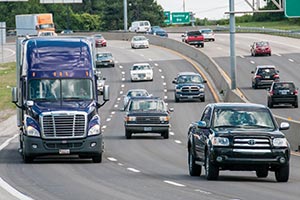Feds Say Americans Drove More Miles Last Year Than in Each of Previous Seven

The new mileage figures show the need for greater investment in transportation infrastructure and affirm the projections Transportation Secretary Anthony Foxx included in his recently released “Beyond Traffic” report, FHWA said in a statement released March 12 with the new traffic statistics.
The Foxx report is a 30-year look forward at the social and business factors affecting transportation and funding needs.
“Americans are driving their cars at near-record levels, and being stuck in traffic is costing drivers an average of nearly five days a year,” Foxx said in the FHWA statement.
“To ensure this problem doesn’t get worse, greater innovations and investments are needed,” Foxx said. “We can’t keep treating America’s 21st-century traffic needs with 20th-century solutions.”
According to FHWA’s report, “Americans drove 3.015 trillion miles last year, roughly the same distance as 323 round trips from Earth to Pluto.”
The report does not break out car miles versus truck miles.
In December alone, however, all drivers logged 251.4 billion miles, the highest level for any December since data collection began in 1939.
“At 5% higher than the previous December, it was the year’s biggest single-month increase and the nation’s 10th consecutive month of VMT growth,” FHWA said.
“Traffic in the South Gulf — a block of eight states including Texas and Kentucky — rose to nearly 49.1 billion vehicle miles traveled [VMT], a gain of 6.4% over the previous December and the 10th consecutive month of increased traffic for the region,” the agency said.
All states recorded traffic increases in December. Indiana, at 10.5%, led the nation with the largest single-state traffic increase compared to the same month a year earlier.
Oklahoma and Montana followed at 9.3% and 8%, respectively.
“Data like these are critical to helping federal and state transportation leaders understand the challenges facing American drivers,” Deputy Federal Highway Administrator Gregory Nadeau said.
“The nation’s growing demand on roads and bridges underscores what we have been saying — increased investment is needed if we are to keep our roads from becoming parking lots,” he added.
Despite the latest figures, many analysts have been pressing for changes in transportation policies because Americans seem to be less interested in driving cars, especially, younger people.
Phineas Baxandall, senior analyst and transportation program director at PIRG, said it would have “been surprising not to see some uptick in driving given the confluence of temporary factors in 2014.”
There were large increases in employment last year and a big drop in gasoline prices, yet the rate of increase in driving still was smaller than the normal increases for six decades before 2005, Baxandall said in a statement.
“The total volume of driving in 2014 still fell below 2007 levels, even despite the nation’s larger population,” he said.
“Technological and demographic factors, plus urbanization and the preferences of an emerging Millennial generation all suggest that increases in driving will be slower than in past generations,” he said.
“The volume of driving could be even lower if public policies in coming years give Americans more choices about whether or not to drive,” Baxandall added. “We hope that this past year’s data does not distract public leaders from the profound changes under way in transportation.”

